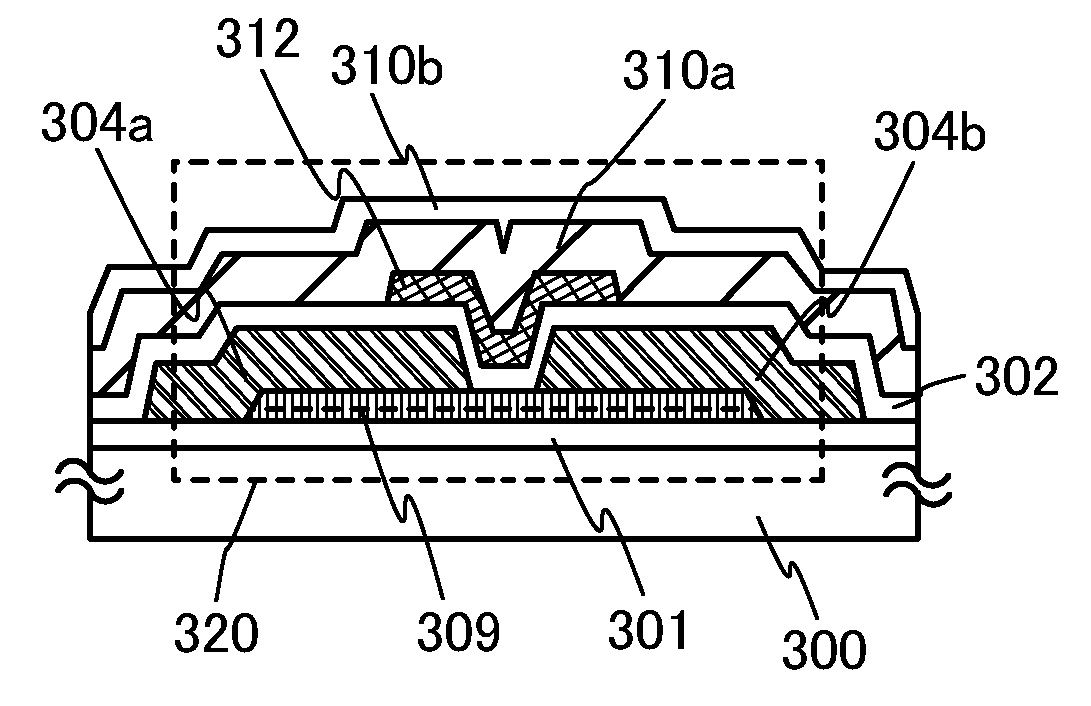Oxide semiconductor film and semiconductor device
- Summary
- Abstract
- Description
- Claims
- Application Information
AI Technical Summary
Benefits of technology
Problems solved by technology
Method used
Image
Examples
embodiment 1
[0032]In this embodiment, a structure of an oxide semiconductor film which contains indium (In), gallium (Ga), and zinc (Zn) will be described with reference to FIGS. 1A and 1B, FIG. 2, and FIGS. 3A and 3B.
[0033]An oxide semiconductor film according to this embodiment which contains indium (In), gallium (Ga), and zinc (Zn) includes a c-axis-aligned crystalline region aligned in the direction parallel to a normal vector of a surface where the oxide semiconductor film is formed. The composition of the c-axis-aligned crystalline region is represented by In1+δGa1−δO3(ZnO)m (0xGayO3(ZnO)m (0
[0034]An oxide semiconductor film was actually formed, and a cross section thereof was observed with a TEM (transmission electron microscope). FIGS. 1A and 1B (cross-sectional TEM images) show the results.
[0035]A sample shown in the cross-sectional TEM image of FIG. 1A was obtained as follows. An oxide semiconductor film 101 was deposited over a substrate 100 t...
embodiment 2
[0070]In this embodiment, a method for forming the oxide semiconductor film which contains indium, gallium, and zinc and includes the c-axis-aligned crystalline region, described in Embodiment 1, and a method for manufacturing a transistor including the oxide semiconductor film will be described with reference to FIGS. 4A to 4E and FIG. 5. FIGS. 4A to 4E are cross-sectional views illustrating a manufacturing process of a top-gate transistor 320. FIG. 5 illustrates an example of a structure of a manufacturing apparatus. Unlike in Embodiment 1, a method for forming the oxide semiconductor film which includes the c-axis-aligned crystalline region through two separate steps will be described in this embodiment.
[0071]FIG. 4E is a cross-sectional view of the top-gate transistor 320. The transistor 320 includes, over a substrate 300 having an insulating surface, an insulating film 301, an oxide semiconductor film 309 including a channel formation region, a source electrode 304a, a drain el...
embodiment 3
[0115]In this embodiment, transistors whose structures are different from a structure of the top-gate transistor 320 described in Embodiment 2 will be described with reference to FIGS. 6A to 6C. Components that are similar to the components of the transistor 320 described in Embodiment 2 are denoted by the same reference numerals, and description of such components is not repeated.
[0116]In the transistor illustrated in FIGS. 6A to 6C, the oxide semiconductor film which contains indium, gallium, and zinc and includes the c-axis-aligned crystalline region, described in Embodiment 1, is used for a channel formation region, whereby the transistor can have high reliability.
[0117]A transistor 330 illustrated in FIG. 6A includes the insulating film 301 provided over the substrate 300; the source electrode 304a and the drain electrode 304b provided over the insulating film 301; the oxide semiconductor film 309 provided in contact with upper surfaces and side surfaces of the source electrode...
PUM
 Login to View More
Login to View More Abstract
Description
Claims
Application Information
 Login to View More
Login to View More - R&D
- Intellectual Property
- Life Sciences
- Materials
- Tech Scout
- Unparalleled Data Quality
- Higher Quality Content
- 60% Fewer Hallucinations
Browse by: Latest US Patents, China's latest patents, Technical Efficacy Thesaurus, Application Domain, Technology Topic, Popular Technical Reports.
© 2025 PatSnap. All rights reserved.Legal|Privacy policy|Modern Slavery Act Transparency Statement|Sitemap|About US| Contact US: help@patsnap.com



